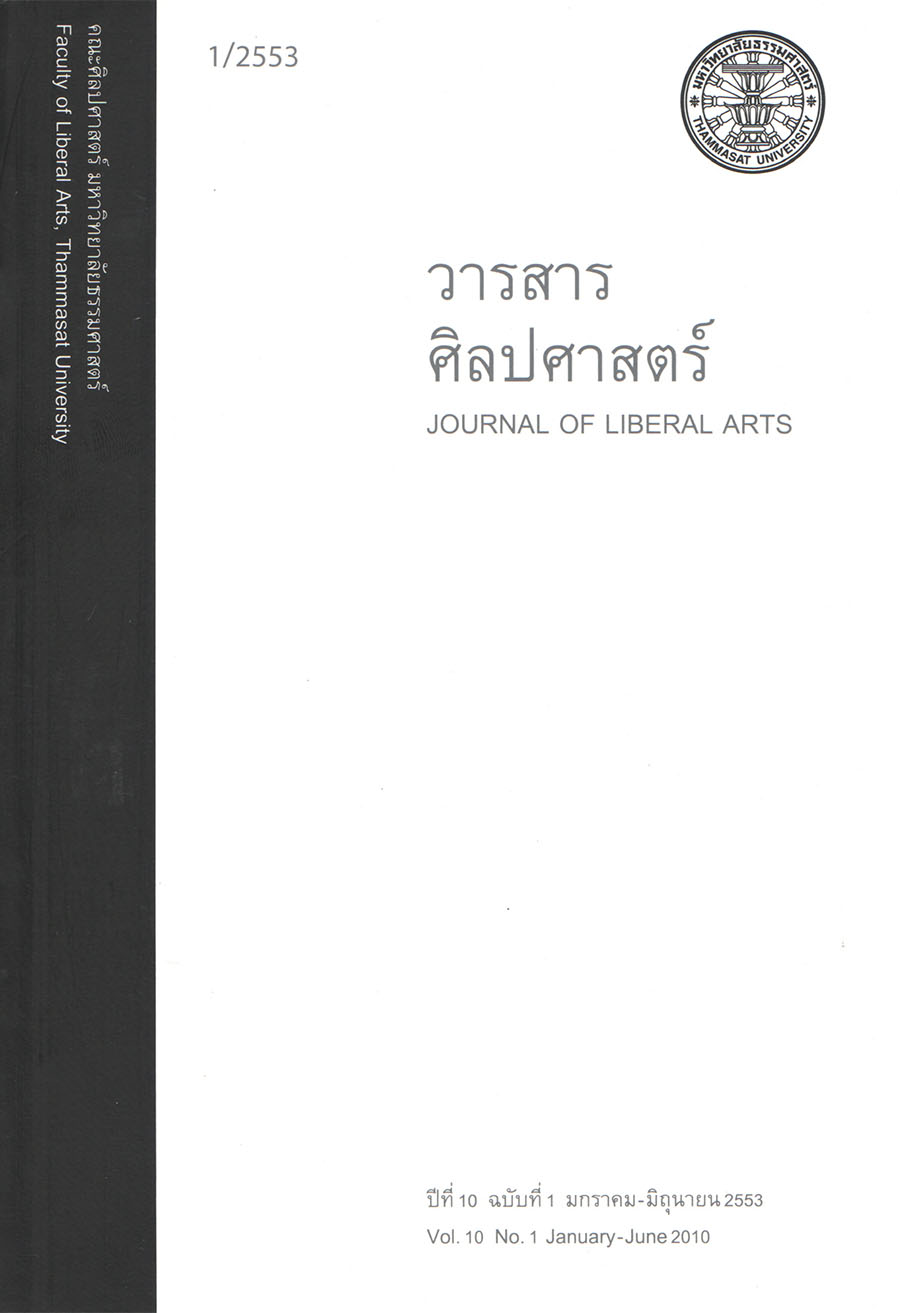การศึกษาอุปลักษณ์เชิงมโนทัศน์เกี่ยวกับผู้หญิงในวรรณกรรมนิราศ
Main Article Content
บทคัดย่อ
การศึกษาอุปลักษณ์เกี่ยวกับผู้หญิงในวรรณกรรมนิราศมีวัตถุประสงค์เพื่อศึกษารูปภาษาที่นำมาใช้เปรียบเทียบกับผู้หญิงในวรรณคดีนิราศ เปรียบเทียบรูปภาษาที่ใช้เปรียบเทียบกับผู้หญิงของวรรณกรรมนิราศต่างสมัย และศึกษามโนทัศน์ของผู้ใช้ภาษาที่มีต่อผู้หญิงจากอุปลักษณ์เชิงมโนทัศน์ที่ปรากฏในวรรณกรรมนิราศ โดยผู้วิจัยเก็บรวบรวมข้อมูลจากวรรณกรรมนิราศ 3 สมัย คือ วรรณกรรมนิราศในสมัยอยุธยา จำนวน 10 เรื่อง วรรณกรรมนิราศในสมัยรัตนโกสินทร์ ตั้งแต่รัชกาลที่ 1- รัชกาลที่ 6 จำนวน 25 เรื่อง และวรรณกรรมนิราศในสมัยรัตนโกสินทร์ ตั้งแต่รัชกาลที่ 7 – ปัจจุบัน จำนวน 25 เรื่อง ผลการศึกษาพบว่าผู้ใช้ภาษาใช้อุปลักษณ์ 3 ประเภทเพื่อกล่าวเปรียบเทียบถึงผู้หญิง คือ อุปลักษณ์สิ่งมีชีวิต อุปลักษณ์สิ่งไม่มีชีวิต และอุปลักษณ์สิ่งเหนือธรรมชาติ โดยมีการใช้อุปลักษณ์สิ่งมีชีวิตเพิ่มขึ้นตามลำดับยุคสมัย อุปลักษณ์สิ่งไม่มีชีวิตมีจำนวนที่ลดน้อยลงตามลำดับยุคสมัย ส่วนอุปลักษณ์สิ่งเหนือธรรมชาติพบว่ามีจำนวนไม่มากนักและมีจำนวนเพิ่มขึ้นหรือลดน้อยลงในแต่ละสมัยไม่ต่างกัน ส่วนการศึกษามโนทัศน์พบว่าในสมัยอยุธยา ผู้ใช้ภาษามีระบบความคิดที่มองเห็นว่าผู้หญิงเป็นเพียงสิ่งไม่มีชีวิตที่มีประโยชน์ในการใช้งานเท่านั้น ส่วนในสมัยรัตนโกสินทร์ รัชกาลที่ 1 – รัชกาลที่ 6 สะท้อนให้เห็นมโนทัศน์ของผู้ใช้ภาษาส่วนหนึ่งที่มีความคิดสอดคล้องกับสภาพสังคมและวัฒนธรรมที่มีลักษณะใกล้เคียงกับสมัยอยุธยา คือ ผู้ชายมีอำนาจและบทบาทเหนือกว่าผู้หญิง แต่ในขณะเดียวกันสภาพสังคมที่เปลี่ยนแปลงไปในสมัยนี้ทำให้ผู้หญิงมีบทบาทในสังคมเพิ่มขึ้นกว่าในสมัยอยุธยา ทำให้ผู้ใช้ภาษาส่วนใหญ่ให้ความสำคัญกับผู้หญิงในฐานะเป็นสิ่งมีชีวิตมากขึ้น และสุดท้ายอุปลักษณ์เกี่ยวกับผู้หญิงในวรรณกรรมนิราศในสมัยรัตนโกสินทร์ รัชกาลที่ 7 – ปัจจุบัน แสดงให้เห็นว่าในสมัยนี้ผู้ชายให้ความสำคัญกับผู้หญิงในฐานะเป็นสิ่งมีชีวิตมากยิ่งขึ้น และมีความคิดว่าผู้หญิงเป็นสิ่งไม่มีชีวิตลดน้อยลง
This research aims to study the language forms that were used for women in niras literature and finds the similarities and contrasts among these language forms in different eras, and to study as well the language users’ concepts regarding these metaphors on women in niras Literature. The researchers collected data from 3 eras of niras literature as follows: 10 works of niras literature in the Ayutthaya era, 25 works in the earlier Rattaakosin era (King Rama I-VI) and 25 works in the later Rattanakosin era (King Rama VII-present. The research found that the language users used three types of metaphors to present women: 1) live metaphor, 2) non-live metaphors and 3) supernatural metaphors, while using more of live metaphor and less non-live metaphor. The live metaphor has been used increasingly with each passing era while the non-live metaphor has been used less and the supernatural metaphor has not been used much-nor has it level of use changes much. As for the conceptual study, in the Ayutthaya era, language users considered women as non-live subjects that were only useful. In the earlier Rattanakosin era (King Rama I-VI), the language concepts expressed the ideas in line with the social conditions and cultural characteristics that were similar to those in the Ayutthaya era, reflecting the fact that men had more power and more authority than women. At present, since conditions in modern society have changed and women have a greater role in society, language users consider women more as live subject than in the past. Finally, women’s metaphors in niras literature show that in the earlier Rattanakosin era and in King Rama VII-present era, women were considered to be live subjects more commonly than they were in the Ayutthaya era.


